We all love shooting and hitting our targets. Some of us have gone beyond shooting cans behind the barn to hitting targets far, far out. Others go all in in practical shooting, with IPSC hangdun/rifle /shotgun or 3 Gun.
Regardless why we shoot, it’s always nicer to be high up in the list of competitors, or even stand on the podium.
So let’s start 2017 with a suggestion on how you can improve your score.
The Challenge
For practical shooting, a national championship usually involves a minimum of 12 stages and 2 days of shooting. The European Championship involved 24 stages, a World shoot 30. It’s physically and mentally demanding to be performing at top level at each stage.
Normally you get 3-5 minutes for your walk-thru, to mentally “shoot” your stage and memorize it.
Some of these stages are very simple, and only takes about 20 seconds to understand even for a beginner.
However (and unfortunately in my opinion) some stages are more about memorization than shooting, and you always feel you didn’t have enough time before the timer goes “beeeeep” and you’re supposed to produce Alpha-hits at the shortest time ever.

The more prepared you come to the stage, the more you can focus on the safe and accurate execution.
You have to know where the sweet sports are, and which targets to shoot in each position. I find some stages in shotgun being the most difficult, all you see is a lot of steel hidden behind tires, and after a while you have no clue if that steel has been “shot” and already in your plan, or if it’s a new target you need to take into plan. With shotgun, there might be a lot of dust as well, as you shoot the stage, so you need to know where to expect the next target. It’s like a Matrix, you need to know where the target is, even in complete darkness.
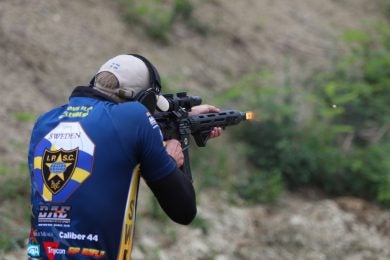
In practical rifle (IPSC), the distances are typically from 5 to 300 meters, but sometimes longer. We had 380 meters at the Nordic Championships, with a lot of wind. Most people (at least in Europe) are glad if they have a shooting range up to 100 meters, let alone 300 meters. In the US this is likely different, but the methods described below are the same. Shooting positions are sometimes very demanding, and if you place yourself in the sweet spots seconds can be shaved off.
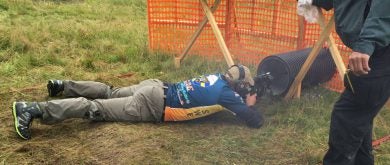
For handgun and shotgun, you don’t have to bother too much about ballistics (with slugs, yes some).
But for rifle this is essential, you must know your ballistics or you will fail.
I’m not going to go into the different methods of aiming in rifle too deep, but most either “know their zero” and aim higher or lower depending on the distance to their target.
I used to do this with my Swarovski Z6i 1-6x (LD-I reticle).
I have now switched to the latest Zeiss V8 1-8x (Reticle 54) and I use the ASV turret. The ASV turret is a bullet drop compensator, so you dial in the distance you are shooting and the rifle is then zeroed at this distance. For sure, this has to be verified with your rifle and ammunition before your competition.
For the record, I do find the switch from 6 to 8 power very helpful in the long range stages.
The Zeiss ASV is explained in detail here. Other manufactures may have similar solutions with different brand names.

The Hardware
To accomplish the notes below, you need an Apple iPad Pro. Other devices and software may work, please let us know in the comments section below.
What makes the Pro a bit special is the Apple Pencil. It’s sensitive to both tilt and pressure, so you can create a range of artistic effects on your images and pdfs. To do what we are looking for in our exercise, only the basic functions are needed.

The Software
The App used below is called Notability by Ginger Labs. Again, there may be other Apps out there that would work.
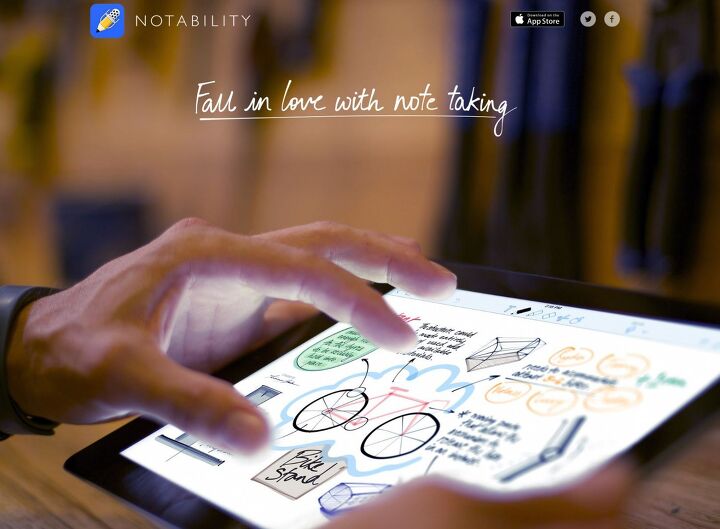
The Solution
All credits for this method goes to my mentor and overall aid in keeping my firearms (and magazines) running, Johan Hansen. Thank you very much, I owe you a lot.
In almost every (all?) large competitions you get a stage description on a pdf file. I haven’t shot any competitions in the US yet, but I guess you get something similar?
The pdf is your start, this is what you use to add your notes. Typically, this can be downloaded from the match homepage or SSI Shoot’n Score it.
You need to spend some time looking at the stages, this can preferably be done during the Pre-Match, or if it’s a longer championship during your spare time. If you see pro shooters dealing with a stage, even better. I’m sure they’ll be flattered if you copy their solution.
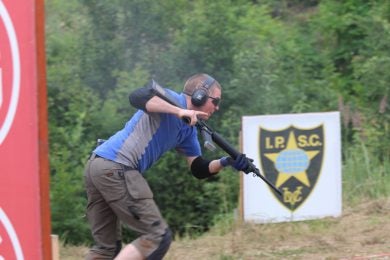
Bring a laser range finder (essential for rifle, slugs and the odd long range pistol target) and possibly a timer if you need to time swingers or other movers.
Find out the distances to different targets. You can’t walk inside the stage, but you can check the range to the target and withdraw the distance to your supposed shooting position from where you stand. It’s simple.
Examples
Below is an example from an IPSC rifle match end of October, Blacksmith Rifle Open in Sweden.
This is what you’re provided with as a start.
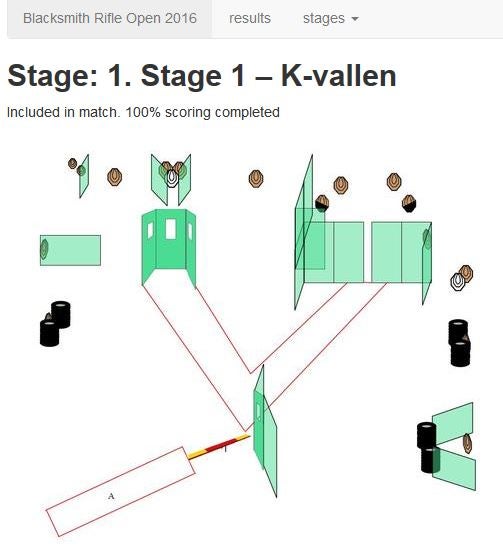
In the notes below, Johan Hansen has added “300 m” which would be the setting for the ASV. He’s only shooting 10 – 30 meters, but the 300 meter setting is suitable for this as well. This is his zero, yours might be different.
He’s going to shoot the stage with the sight set on 1x magnification (on the Zeiss V8 it’s actually 1.1, but I don’t really notice the difference).
On the beep, he’s going to shoot 30 meters from position 1, then move to 2 and shoot 2 targets at 12 meters. Then onto position 3, 4, 6 and 6 as pictured.
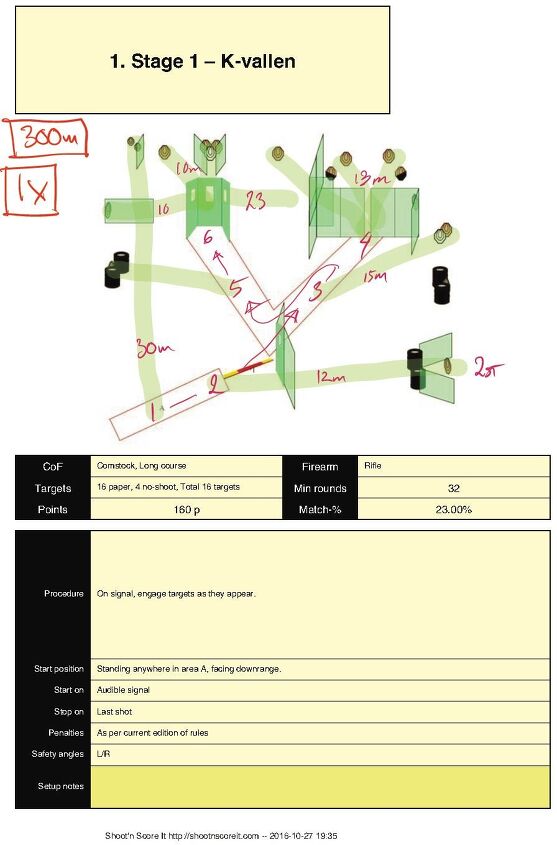
Simple! With those notes, he (or almost anyone) can step into the stage with great confidence and be mentally prepared for what’s going to happen.
So, how did it go?
Pretty good actually, he got a stage win and pocketed a lot of nice points. Stage 1 weighted 23% of the entire match! Unfortunately he had a lot of problems on other stages, your gear needs to work too.
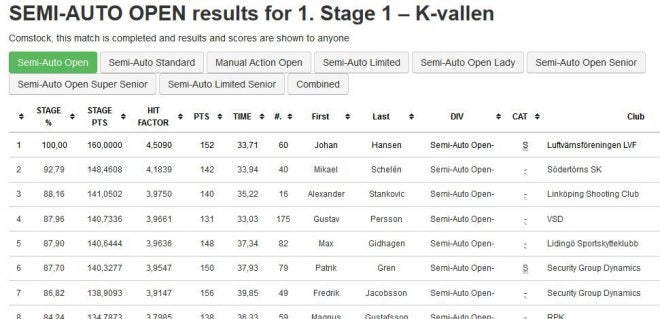
Results for the stage above
Another example. Nordic and Swedish Championship in IPSC Mini Rifle (.22 LR). Stage 10. A simple stage, free order free style, but you must shoot in all three positions to get all targets. Setting 50 meters, 4x magnifications as the steel was only 10×10 cm and there were IPSC Mini targets with no shoots around. The note says: “left knee on the ground”, so you get the support from your right knee to your hand holding the pistol grip and trigger. Johan finished 3:rd at 90%, I got 6:th and 81% as I sucked shooting the steel. We still walked away with 1:st and 2:nd positions overall in the match.
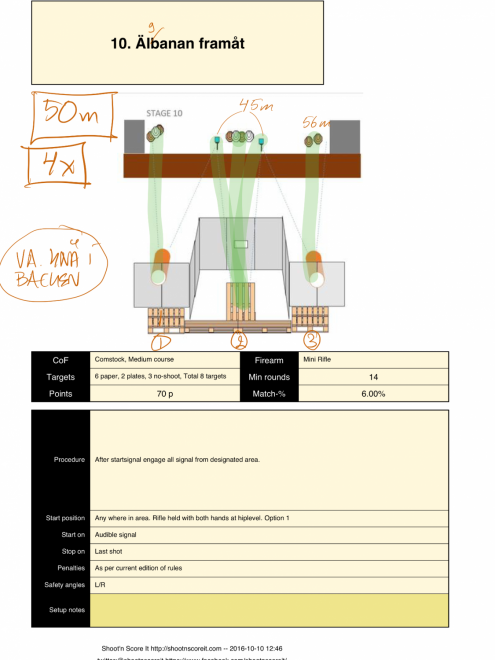
Some more examples, from EHC2016. This is the European Handgun Championship that some 1 000 competitors had a go at.
These stages are a bit more complicated. As you can see they involve movers and so many different options on how and where to shoot from.
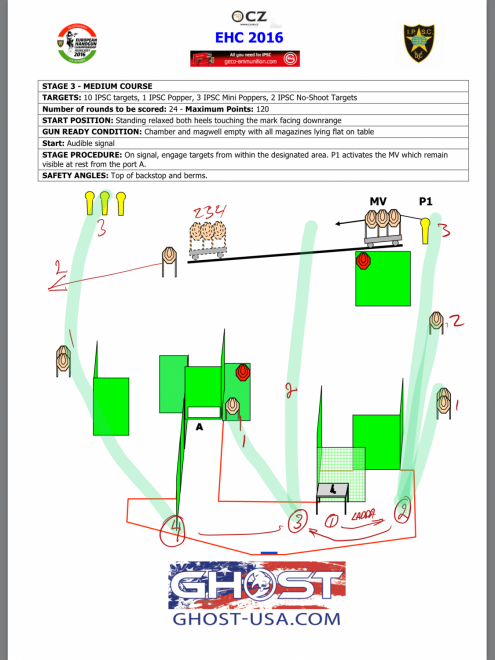
If you like to see Eli Huttner from Double Alpha Equipment shooing this stage, check out this YouTube clip. By the looks of it, he used the same solution. Great minds think alike.
Stage 4. A rather confusing medium course in IPSC handgun. There’s a lot of yellow steel out there, and a lot of people did not get all of them as a result of bad planning and possibly forgetting where to stop and when. If you don’t shoot a steel target, that’s normally 1 procedure (-10p) and 1 miss (-10p) and the points you didn’t get as you didn’t hit it. Huge setback. The pdf with the notes below is one way of doing it. Left hand shooters would most likely do it mirrored.
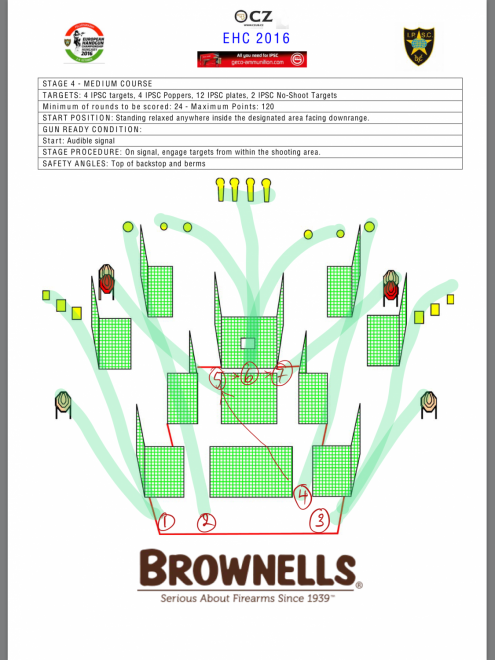
Below: Stage 8, short course at the EHC2016. From position 1 you start loading your gun into position 2, where you shoot T1, cross over to T3 and move to position 3, shoot all the steel and move to position 4 and shoot T2 and T4. Finished.
With notes like this, you can focus on the execution of the stage, instead of the solution. Some of your competitors will start from target finding, problem solving and then finding their solution. You’re already ahead.
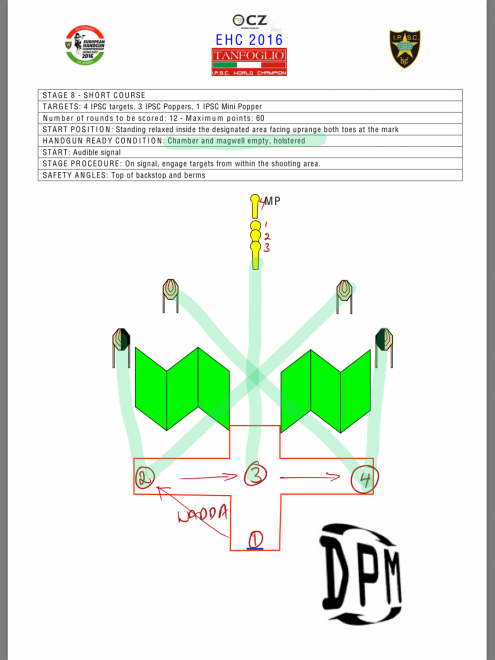
Below: Stage 18, Doors and Movers. Do you shoot the swinger first, or do you shoot the steel or the fixed papers? Look at others, write your notes. Makes life easier as you get your 5 minute walk-thru.
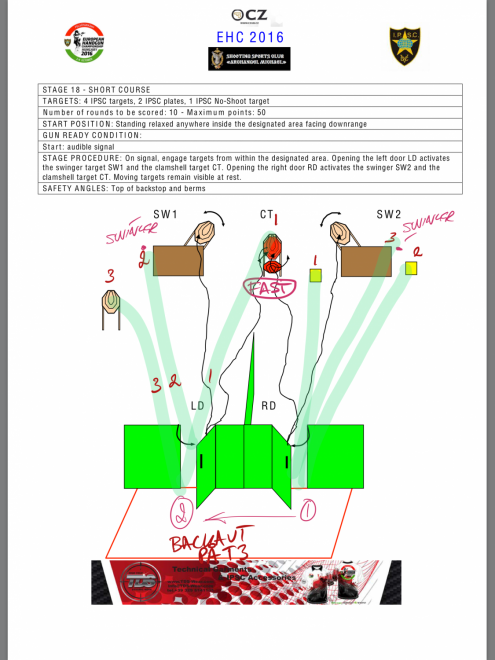
Let’s leave the handgun shooting behind and step into the world of rifles. Your point of aim becomes increasingly important now.
Stage 3, I think this is from the WCRO / JP Challenge which also worked as the Swedish Championships 2016. The most difficult target is at 100 meters, so the Zeiss V8 1-8x and its ASV (ballistic turret) is set to 100 meters, and 3x magnification. Ideally you want higher, but there’s some target acquisition to be done and this is easier (and more important than a higher zoom) with 3x. The small red crosses on the targets is where you need to put your reticle on the target. How do we know this? We use a ballistic app like Strelok Pro.
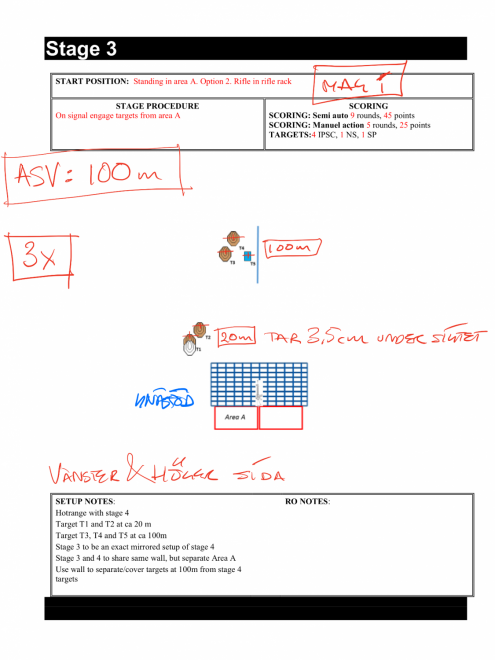
Going advanced
A rifle stage with a very low opening. Competitors must tilt the rifle to be able to shoot. The note says that the opening is only 25 cm (10″), way too high for an AR15 with optics.
Notes says ASV 100 meters and 4,5 magnification. As you can see, nothing fools Johan and his attention to details with his laser range finder. The actual distance is 98 meters! Use a 20 round magazine to get down low.
Then comes some mathematics to calculate the drop with the tilted rifle. I would have preferred an actual verification, we do this from time to time but seem to forget the results all the time too.
Anyway, Johan finished 3:rd at 81% on this stage. 30 people, or 34%, ZEROED the stage. Come prepared next time.
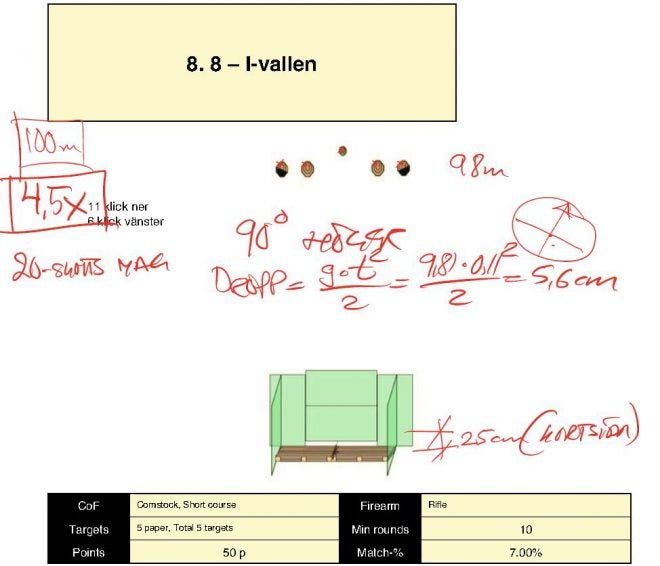
Here’s another usage. Instead of the schematics, you can replace the stage brief with an actual picture of what the stage is going to look like. This may only work on a few stages, as they often don’t fit in one picture.
The ASV is set 350 meters (same zero as 20-25 meters), magnification 1x. Shooting standing in all positions, as numbered.
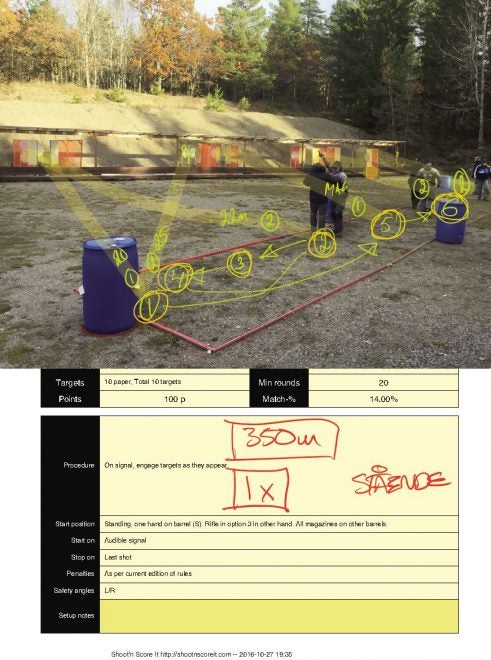
Another example where the stage brief has been switched with actual pictures of the stage. This is great to look at, as you try to visualize your upcoming stages.
Notes, ASV 300 m, 2,5x magnification. Shooting with long bipods or standing? Actual distance unknown. In some cases you will be waling into the unknown.
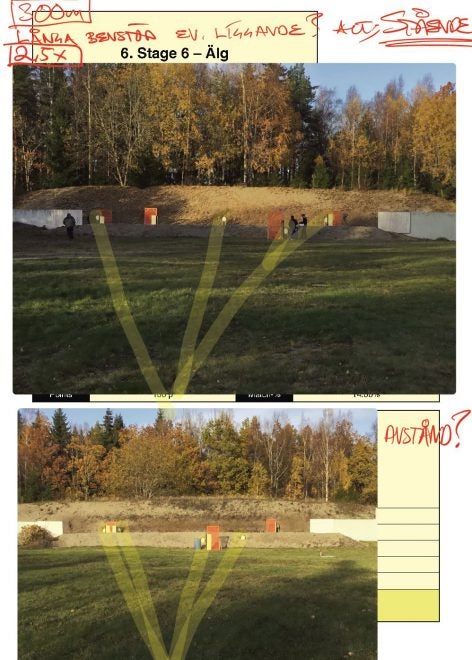
I’m pretty sure this method could also have a place in a tactical environment, to brief a squad in a hostage situation using live pictures for instance. Or plan how to protect an area, the possibilities are endless really.
Just like the EHC2016 brief was shared with the National Team, you can share it with your squad, friend etc. through e-mail, Dropbox etc. The best way to store it on an Apple device is iBooks, as the reception might be useless at the shooting range.
Hunters could probably use it too, from fixed shooting positions. How far is that tree, and where’s my hold over then depending on target?
I hope you liked this. Sharing is caring and we love to get feedback so we can all improve on our level of shooting.
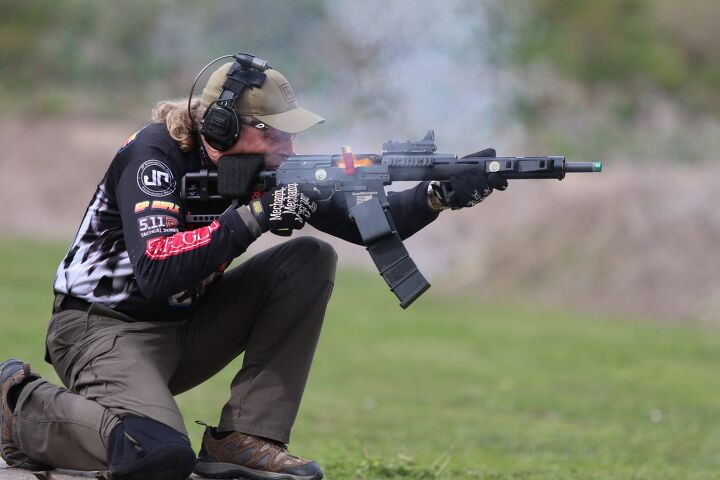
Above: Johan Hansen with his RnR Shotgun.
 Your Privacy Choices
Your Privacy Choices
